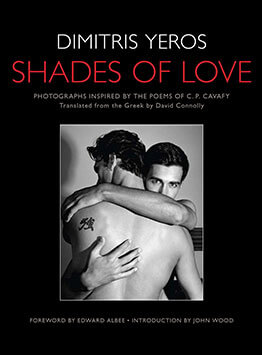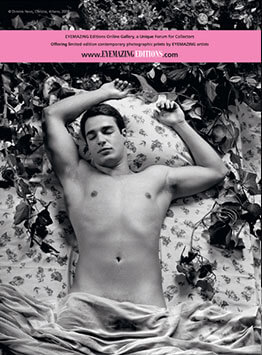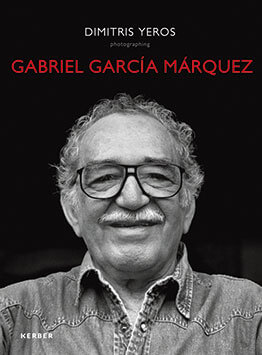EYEMAZING magazine
Issue 01-2012
Dimitris Yeros: Shades of Love
By Clayton Maxwell
My life is spent in the ebb and flow of pleasure, in erotic fantasies—sometimes realized.
My work leans toward thought.
Perhaps rightly so.
Then my work is like the amphora I mentioned. It allows for different interpretations.
And my love life has its own manifestation—obscure only to the ignorant. Expressed more broadly, it may not have been enough of an artistic field for me to stay, to be enough for me.
I work like the ancients. They wrote history, they created philosophy, dramas of a mythological tragic nature—sensual—so many of them—just like me.
C.P. Cavafy, 20-6-1910
As translated for the opening of Dimitris Yeros’s Shades of Love
Greek photographer Dimitris Yeros’s latest book, Shades of Love, is a virtuosic blend of image and poetry. A decade-long labor of love by one of Greece’s most accomplished photographers, the project combines Yeros’s masterful black and whites with select poems by C. P. Cavafy, Greece’s celebrated poet who died in 1933. Cavafy, beloved by Greeks and bibliophiles, is less known to the world at large. Yeros’s images artfully breathe new life into the poems and place them within reach of a wider audience.
It is no surprise that Cavafy’s poetry would inspire a fellow Greek artist. Cafavy’s life is rich in material: he was a gay poet at the turn of the 19th century who bucked norms and openly embraced his sexuality. Well-read and well traveled, he was both an aristocrat and polymath; he lived in Alexandria, England, Constantinople, and France, but spent the majority of his life in Alexandria. His poetry, however, was written in Greek; Yeros commissioned a new translation by David Connolly especially for this project. (Playwright Edward Albee writes the forward, and photography critic John Wood the introduction.) An amalgam of visual arts and literature that is both handsome and invitingly naughty, Shades of Love has attracted the attention of both poetry and photography lovers worldwide.
Yeros transforms this project into a particularly enlivening journey by pairing Cavafy’s poems with portraits of the world’s top men of arts and letters (with one Greek-American actress—Olympia Dukakis-- as the exception.) Gore Vidal, Gabriel García Márquez, Carlos Fuentes, David Leddick, Duane Michals, Jeff Koons, Naguib Mahfouz, Jean Baudrillard, and many more fill the pages of the book. This addition makes Shades of Love far more than just a coupling of poetry and photography: Yeros is taking the particular—one man’s poems—and highlighting their universal reach by bringing in new personalities to embody them. Shades of Love is a visual testament to these words that Cavafy wrote a hundred years ago: “ I work like the ancients. They wrote history, they created philosophy, dramas of a mythological tragic nature—sensual—so many of them—just like me.” Just as Cavafy is like the ancients, so are Yeros and the colleagues he photographs.
Last year, a selection of the images from the book was exhibited at the Michael Cacoyannis Foundation in Athens. In that gallery space, Yeros played recorded readings of Cavafy’s poems by many of the men featured in the book—each recited the poem that accompanied his portrait. This experiential melding of poetry and image moved viewers to tears—the poetry of Cavafy became so present and shimmering you could touch it.
But these famous men do not occupy the photos alone. They are flanked by hunky, naked youth—male models—who serve as a fascinating foil to the dignified older men in the photos. Yeros transforms what could have been a straight up portrait into visual dialogues about relationship and all of the complexities they can contain--yearning, nostalgia, lust, envy, love, etc--exactly what Cafavy explores through poetry.
Yeros is friends with most of the famous men he photographs, which partially explains the intimacy, humor and warmth his images possess—in some of them, you feel like you are getting an inside glimpse into the creative private world of close friends. The already-established relationship translates to a surprising ease in the images.
Consider, for example, the portrait of Edward Lucie-Smith. In it, Yeros creates an interpretation of the poem, And I Sat and Reclined on Their Beds, that is delightful in its humor and tenderness. Lucie-Smith, a British writer and critic, sits on a bed, fully clothed, between two beautiful young men. The accompanying Cavafy poem is:
When I entered pleasure’s house,
I left the room where with propriety
sanctioned loves celebrate.
I went into the secret chambers
and I sat and reclined on their beds.
I went into the secret chambers
thought shameful even to mention
But not shameful to me – for then
what kind of poet or artist would I be?
Better to be a hermit. It would be more in accord
much more in accord with my poetry;
than for me to find joy in that commonplace room.
Yeros’s image highlights the playfulness of the poem. Lucie-Smith, like Cavafy in this poem, does not look at all ashamed of residing in this “secret chamber.” Rather, he looks amused, as if he finds it quite surprising and pleasant to find himself sandwiched between two beefcakes.
Shades of Love emphasizes Cavafy’s unusual outspokenness as a gay man. During the time he was writing, homosexuality was emphatically “thought shameful even to mention.” Which is another reason why Cavafy’s poetry is so unusual—he was speaking out in much bolder terms about his sexuality than any of his contemporaries, even more so than Walt Whitman, a contemporary.
Shades of Love feels like a journey not only into Cavafy’s poetry, but also into the richness of Yeros’s world. In the afterward of the book, Yeros writes amusing anecdotes from the often complicated and bold photo shoots that went into its making. He tells how William Weslow, naked, would repeatedly interrupt the photo shoot to chase away the pigeons from his veranda, furiously waving his arms. And how Clive Barker refused to be shot naked because he didn’t want his penis to look smaller next to that of his partner. The very tales behind these images contain all of the drama, vanity, warmth and allure of a really good poem.
A fine raconteur, Yeros revealed via email the back story to one of my favorite images: the writer David Leddick sitting in a chair at home, naked, with two hunky young men standing behind him. Yeros wrote to me in an email, “When I telephoned David Leddick and told him I wanted to photograph him naked, at first he was surprised but, as he has a sense of humor, he then said, “Oh, OK, but I never want to see this photograph.” At a later date he told me he was very happy I had photographed him and that it was his only naked picture. Before going to Miami for the photo shoot, I asked him if he could find two or three boys to pose with him. He said he would, found a few and sent them to the hotel for my approval. But they were all ugly. I phoned him and told him that they were not good-looking enough to be photographed with him, and he said: “Oh, I suppose I wasn’t wearing my glasses when I met them!”
I love this photo of Leddick because, while he is not as obviously physically beautiful as the young men who did end up in the photo, he looks at ease and confidant naked. There is an important point that is made here, a point which I think Cavafy doesn’t necessarily address but this image inherently does, whether consciously or not: youth does not determine beauty. Leddick’s confidence as an older man lounging in his chair naked expresses a kind of sexiness that mere youth often does not touch.
But what about the beefcakes? What role do they play other than eye candy? Actually, given the tone of Cavafy’s poetry—that is probably the exact role they are supposed to play. So many of Cavafy’s poems focus on youthful beauty, placing their gaze on those hotties of the firm round buttocks and sculpted pecs, evocations of the Greek Ideal. In one photo, a young man stands amidst crumbling antiquities. His bottom faces us, as perfectly shaped as a marble statue of Eros. Yeros (whose name, I must note, is simply Eros with a Y) is deliberately playing with Greece’s history as center of both the ideal human form and gay love since antiquity.
Cavafy’s poems drip with nostalgia and sexual longing. Many possess the voice of an older man whose memories of all consuming passion both feed and haunt him. Yeros’s images visually reinforce this lust for youth and beauty. The image of Leonidas Depian, for example, shows the writer sitting darkly in a chair, his face both pensive and mournful. A younger man wearing only tight underwear stands behind him. Yeros has illuminated the young man, his body lithe and light in contrast to Depian’s position in the shadows. Yeros is playing with Cavafy’s brooding nostalgia for youth and beauty. It is a somber theme--an elderly man, no longer deemed attractive, resigned to the shadows of desire.
Cavafy’s poem To Remain recounts one of those bittersweet nights full of the tension of desire and satisfaction, the prevailing mood of Shades of Love:
To Remain
It must have been one in the morning,
Or half-past one.
In a corner of the tavern;
Behind the wooden partition.
The place was completely empty save for the two of us.
An oil lamp provided scant light.
The drowsy waiter was dozing by the door.
No one would have seen us. Yet already
We were so aroused,
That we’d become incapable of caution.
Our clothes were half-open—not that there were many
For the divine month of July was blazing hot.
Pleasure of the flesh through
The half-open clothes;
Quick baring of the flesh—the image of which
Crossed twenty-six years; and has come now
To remain in this poetry.
Who doesn’t return again and again to the juiciest moments of wanting and satisfaction? Obviously, such pleasure is intrinsically short-lived. Obvious, but still it stings, and we all lash out against that truth in one way another. Art and poetry are amongst the more beautiful and noble ways we soften the sting.










